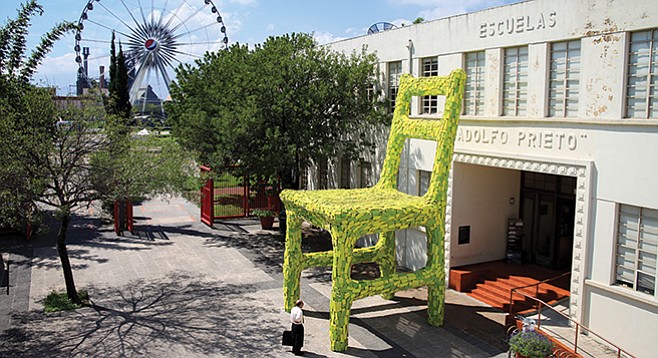 Facebook
Facebook
 X
X
 Instagram
Instagram
 TikTok
TikTok
 Youtube
Youtube

The City of San Diego has picked yet another controversy-prone artist from out of town to create a public work of art, this time for downtown’s forthcoming East Village Park. “I think that public art more and more is becoming a more powerful tool, an adaptive tool, to really drive improvements in our 21st century cities globally, as well as here locally in San Diego,” Christine Jones, the senior public art manager for the city’s Commission for Arts and Culture recently told public TV station KPBS.
By order of the city council, 2 percent of a public project’s construction cost is earmarked for selected artists, who parachute in from around the country to do their thing. In the current case, the chosen creator is Brooklyn’s Mark Reigelman, whose more notable creations include giant chairs next to buildings, a miniature house with a smoking chimney placed in the middle of busy New York streets, and a 20-foot-high, 500-foot-long fence consisting of 18,720 recyclable polyethylene tubes strung around the Cleveland Museum of Art’s east wing.
“The sculpture paid tribute to ancient midsummer-related traditions,” says the artist’s website. “Today, we are forced to stop thinking about art as beautiful paintings or sculptures and think about them as triggers for experiences,” Reigelman has declared.
The experiences he will cook up in San Diego remain in the brainstorming stage, with the artist set to take a meeting last Wednesday with curious post-modern art fans and city officials at the NewSchool of Architecture & Design on Park Boulevard. “You are invited to shape public art for your park,” said an online invitation to the event. A July contract for the project says Reigelman will receive $475,000 from city taxpayers for his efforts here, noting that “the process of developing, reviewing and approving an artwork for the City is an open and transparent process which may include public participation and scrutiny.”
A similar public-input drill turned bitter for Reigelman in the fall of 2011, when the threat of lawsuits derailed his plans to mount almost 600 plastic bicycle handles with lime-colored streamers on a parking garage over an elaborate new bike rack and showering complex being installed by the City of Cleveland. “Developers of the nearby casino don’t want the risk that comes with some yahoo using the eye-catching handles to climb the side of the garage,” reported the Plain Dealer.
Asked if the city should have nixed the bike-grip design early on, Chris Warren, chief of regional development for Mayor Frank Jackson, said, ‘You live and learn. You go through a process.’” The artist was not mollified. “If we lived our lives thinking about what stupid people might do, we would build nothing,” the New Yorker told the paper. “If a guy is going to climb to the top of the New York Times building, he’ll do it. We have to be careful, but we can’t design around what every crazy person might do.”


The City of San Diego has picked yet another controversy-prone artist from out of town to create a public work of art, this time for downtown’s forthcoming East Village Park. “I think that public art more and more is becoming a more powerful tool, an adaptive tool, to really drive improvements in our 21st century cities globally, as well as here locally in San Diego,” Christine Jones, the senior public art manager for the city’s Commission for Arts and Culture recently told public TV station KPBS.
By order of the city council, 2 percent of a public project’s construction cost is earmarked for selected artists, who parachute in from around the country to do their thing. In the current case, the chosen creator is Brooklyn’s Mark Reigelman, whose more notable creations include giant chairs next to buildings, a miniature house with a smoking chimney placed in the middle of busy New York streets, and a 20-foot-high, 500-foot-long fence consisting of 18,720 recyclable polyethylene tubes strung around the Cleveland Museum of Art’s east wing.
“The sculpture paid tribute to ancient midsummer-related traditions,” says the artist’s website. “Today, we are forced to stop thinking about art as beautiful paintings or sculptures and think about them as triggers for experiences,” Reigelman has declared.
The experiences he will cook up in San Diego remain in the brainstorming stage, with the artist set to take a meeting last Wednesday with curious post-modern art fans and city officials at the NewSchool of Architecture & Design on Park Boulevard. “You are invited to shape public art for your park,” said an online invitation to the event. A July contract for the project says Reigelman will receive $475,000 from city taxpayers for his efforts here, noting that “the process of developing, reviewing and approving an artwork for the City is an open and transparent process which may include public participation and scrutiny.”
A similar public-input drill turned bitter for Reigelman in the fall of 2011, when the threat of lawsuits derailed his plans to mount almost 600 plastic bicycle handles with lime-colored streamers on a parking garage over an elaborate new bike rack and showering complex being installed by the City of Cleveland. “Developers of the nearby casino don’t want the risk that comes with some yahoo using the eye-catching handles to climb the side of the garage,” reported the Plain Dealer.
Asked if the city should have nixed the bike-grip design early on, Chris Warren, chief of regional development for Mayor Frank Jackson, said, ‘You live and learn. You go through a process.’” The artist was not mollified. “If we lived our lives thinking about what stupid people might do, we would build nothing,” the New Yorker told the paper. “If a guy is going to climb to the top of the New York Times building, he’ll do it. We have to be careful, but we can’t design around what every crazy person might do.”
Comments